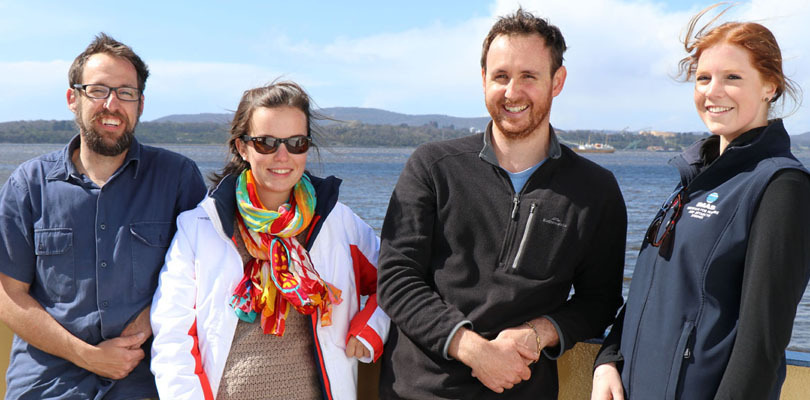October 18, 2016
Young scientists Lainey James and Margot Delaporte have completed their first trip aboard the Australian Maritime College Research Vessel Bluefin.
They spent a week surveying seabed life off eastern Tasmania with a team from the UTAS Institute for Marine and Antarctic Studies and the University of Sydney Australian Centre for Field Robotics.
The team revisited deep reef systems in the Freycinet Commonwealth Marine Reserve (CMR), as well as inshore reefs near Wineglass Bay and ‘The Nuggets’ off Cape Tourville, and at Governor Island Marine Reserve.
A highlight was a return trip to ‘Joe’s Reef’ off Bicheno in the Freycinet CMR, last surveyed in 2012, where spectacular large black corals were photographed by the robotic underwater vehicle Sirius.
Baited remote underwater video systems (BRUVS) were also deployed to survey mobile species such as fish and squid associated with reef systems.

For both students, it was a chance to see how the thousands of seabed images they analyse back at the lab are collected during surveys at sea.
Ms James’s PhD research with IMAS involves developing ways of processing seabed images collected by Sirius so that they can be compared over time, to see how the environment may be changing.
“I’m using special software to measure up all the different types of animals attached to the seabed, such as sponges and corals, and then to recreate the seascape in 3D,” Ms James said. ‘It’s a bit like extending Google Earth underwater.”
Ms Delaporte is visiting Tasmania from France where she is studying environmental science. During an internship with IMAS, she is also working on classifying the animals photographed by Sirius.
“It’s been a great to see how the robot works and to get an idea of the environment the images have come from,” Ms Delaporte said. “We’ve been involved in everything from assembling equipment to viewing the images coming back from the seabed.”
Parks Australia Marine Protected Areas manager Jason Mundy said the research would increase our knowledge about marine reserves off Tasmania and provide insights for management.
“Effective management of our vast marine reserve networks needs to be informed by the best science available,” Mr Mundy said.
“Supporting these research activities and ensuring we have strong partnerships that give scientists the opportunity to undertake this important work is critical for the ongoing welfare of our oceans.”
Flinders CMR extends east of Cape Barren Island and Freycinet CMR reserve extends east of Bicheno. Both reserves provide important reef habitat for popular species caught by commercial and recreational fishers.
“We’re revisiting these areas to learn how the invertebrate cover on these deep reef and relict coastal features changes through time,” said Dr Jacquomo Monk, the lead ecologist on the survey.
“Our surveys will establish a sound baseline from which to monitor future changes that may result from management actions, storms, invasive species, or climate change.”
The TV Bluefin survey was funded by Parks Australia with support from the National Environmental Science Programme (NESP) Marine Biodiversity Hub and Sirius is supported by the Integrated Marine Observing System.
Caption: Justin Hulls, Margot Delaporte, Jacquomo Monk and Lainey James on the RV Bluefin.
- Log in to post comments
